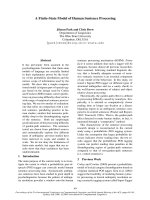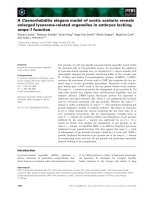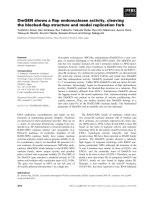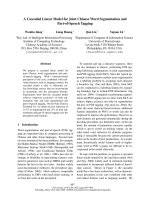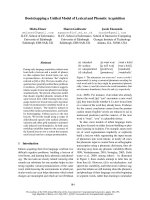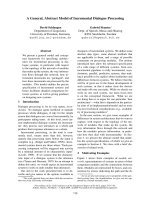cheap talk, valuable results- a causal attribution model of the impact of promises and apologies on short-term trust recovery
Bạn đang xem bản rút gọn của tài liệu. Xem và tải ngay bản đầy đủ của tài liệu tại đây (632.79 KB, 195 trang )
CHEAP TALK, VALUABLE RESULTS?
A CAUSAL ATTRIBUTION MODEL OF THE IMPACT OF PROMISES AND
APOLOGIES ON SHORT-TERM TRUST RECOVERY
DISSERTATION
Presented in Partial Fulfillment of the Requirements for the Degree of Doctor of
Philosophy in the Graduate School of The Ohio State University
By
Edward C. Tomlinson, MBA, MLHR
*****
The Ohio State University
2004
Dissertation Committee:
Approved by:
Professor Roy J. Lewicki, Adviser
Professor Howard J. Klein
______________________
Professor Raymond A. Noe Adviser
Labor and Human Resources
Graduate Program
ii
ABSTRACT
Although prior work on trust has extensively studied the development of
interpersonal trust in professional relationships, the benefits of trust, and the harmful
consequences of trust violations, remarkably little research has been directed toward
understanding the trust recovery process after a violation. Recent empirical work on trust
has provided evidence that trust recovery can be facilitated by promises of future
trustworthiness and apologies for prior trust violations (i.e., forms of “cheap talk” that are
costless for the speaker and unverifiable by the receiver). Notably, cheap talk was related
to the recovery of trust and cooperation even in the short-term, before the victim could
see how the offender would actually behave in subsequent interactions. However, these
studies did not examine theoretical mechanisms that account for this effect or the
boundary conditions under which this effect is most likely to occur. Thus, it remains
unclear why or when cheap talk can facilitate trust recovery.
This dissertation examines how promises and apologies relate to short-term trust
recovery. Drawing upon Weiner’s (1986) causal attribution theory and the literature on
social accounts, it is argued that these forms of cheap talk are negatively related to the
victim’s attributions of stability regarding the cause of the violation. Lower stability
attributions are posited to produce higher hope emotions and lower fear emotions, and
result in higher trust expectancy, as the victim is likely to conclude that future violations
are unlikely to recur due to unstable causes. In turn, emotional reactions and trust
iii
expectancy are predicted to jointly affect short-term trust recovery. This study examines
one possible boundary condition in testing whether the effects of cheap talk on stability
attributions are moderated by offense severity. Finally, this study also considered the
impact of message content versus gesture on short-term trust recovery in order to discern
whether it is the words that are used or the polite gesture of speaking them that is related
to stability attributions.
To test these hypotheses, participants were randomly assigned to one of eight
experimental conditions in a 2 (promise) x 2 (apology) x 2 (offense severity) between-
subjects factorial design, and played a modified version of the Trust Game. The results
indicated that promises and apologies were not related to stability attributions, nor did
these forms of cheap talk interact with offense severity on stability attributions. However,
this study did find that the type of message interacted with offense severity such that
content-free messages (i.e., garbled messages that contained neither a promise nor an
apology) were associated with higher stability attributions relative to content messages
(promises, apologies, promise-plus-apologies) when offense severity was high. This
study also found support for Weiner’s (1986) attribution theory in the context of short-
term trust recovery by highlighting the instrumental role of stability attributions and
specific emotional reactions as key variables in the short-term trust recovery process.
Furthermore, post hoc analyses revealed that although promises and apologies were not
related to stability attributions, significant effects were found for these messages on
perceptions of interactional justice. These results are discussed along with practical
implications, study limitations, and directions for future research.
iv
Dedicated to my fiancé, Beth Reiter,
my parents, Smiley and Linda Tomlinson,
and
my brother, Eric Tomlinson
v
ACKNOWLEDGMENTS
I am grateful to a number of individuals who provided me with invaluable support
and assistance during this project, and I wish to acknowledge their contributions and
express my sincere appreciation. First, I have been blessed with a wonderful family that
has been wholly supportive of my decision to pursue a doctoral degree, even though this
required me to move several hours away from them.
I also thank the members of my dissertation committee. These individuals have
had a profound impact on my professional development, and are exemplary role models
as I embark on my academic career. The chair of my committee, Dr. Roy Lewicki, has
been a remarkable mentor and friend. He has given graciously of his time and energy
throughout this study, and provided me with steady encouragement and inspiration. Both
Dr. Howard Klein and Dr. Ray Noe have consistently provided timely and insightful
feedback, helpful suggestions, and invaluable support.
Many thanks are due to Aaron Lewicki, Jason Gilmore, Jon Shoberg, and Brian
Wilson for their invaluable assistance in developing, refining, and administering the
computer program used in this research. I would also like to thank Dr. Judy Tansky,
Chongwei Wang, and David Zoogah for allowing me to have access to their classes for
research participation, as well as all of the students who agreed to participate in this
study.
vi
I gratefully acknowledge the financial support that was provided for this study by
an Alumni Grant for Graduate Research and Scholarship at The Ohio State University,
and a State Farm Doctoral Dissertation Grant.
I would also like to express my sincere appreciation to the entire management
faculty at the Fisher College of Business for a challenging and rewarding academic
experience. Their dedication to excellence in teaching and research has provided me with
a solid foundation that will serve me well throughout the rest of my career. In this regard,
I especially want to thank Dr. David Greenberger, Dr. Rob Heneman, Dr. Jerry
Greenberg, and Dr. Jill Ellingson.
I have also been fortunate to work with a number of talented and energetic
colleagues as I have progressed through this program. Dr. Carolyn Wiethoff and Dr.
Yaping Gong helped me learn the ropes of the program. Dr. Brian Dineen has been a
close friend as well as a collaborator on several research projects. Monica Wang has also
been a good friend, always able and willing to offer fresh perspective and tireless
enthusiasm. I also appreciate the collegiality and support of Hyondong Kim, Kyra Sutton,
Chongwei Wang, David Zoogah, Chad Brinsfield, Aden Heuser, Janice Molloy, and
Marie-Elene Roberge.
Finally, I would like to express my undying love and admiration for my fiancé,
Beth Reiter. She has been a steadfast source of encouragement and inspiration throughout
the dissertation process. I am grateful for her patience with me during this experience, as
well as her willingness to proofread earlier drafts of this manuscript and assist with data
collection. I am very thankful to have the enduring love and support of such a wonderful
lady.
vii
VITA
April 8, 1971 Born – Lynchburg, Virginia
1993 B.A. Virginia Military Institute
1998 MBA Lynchburg College
2002 MLHR The Ohio State University
PUBLICATIONS
Dixon, M., Wang, S., Calvin, J., Dineen, B. R., & Tomlinson, E. C. (2002). The panel
interview: A review of empirical research and guidelines for practice. Public
Personnel Management, 31, 397-428.
Greenberg, J., & Tomlinson, E. C. (2004). The methodological evolution of employee
theft research: The DATA cycle. In R. Griffin & A. O’Leary-Kelley (Eds.), The
dark side of organizational behavior (pp. 426-461). San Francisco: Jossey-Bass.
Heneman, R. L., Tansky, J. W., & Tomlinson, E. C. (2001). Hybrid reward systems for
virtual organizations: A review and recommendations. In R. L. Heneman & D. B.
Greenberger (Eds.), Human resource management in virtual organizations (pp.
245-262). Greenwich, CT: Information Age Publishing.
Tomlinson, E. C., Dineen, B. R., & Lewicki, R. J. (2004). The road to reconciliation:
Antecedents of victim willingness to reconcile following a broken promise.
Journal of Management, 30, 165-187.
FIELD OF STUDY
Major Field: Labor and Human Resources
viii
TABLE OF CONTENTS
ABSTRACT……………………………………………………………………… ii
DEDICATION………………………………………………………………… iv
ACKNOWLEDGMENTS………………………………………………………… v
VITA……………………………………………………………………………… vii
LIST OF TABLES…………………………………………………………………. xi
LIST OF FIGURES………………………………………………………………… xii
CHAPTER
1. INTRODUCTION……………………………………………………………… 1
Overview……………………………………………………………………… 1
“Cheap Talk” and Rebuilding Trust……………………………………………. 3
Focus of this Dissertation………………………………………………………. 8
2. LITERATURE REVIEW………………………………………………………. 12
Definition of Trust……………………………………………………………… 13
Trust Development and Elements that Facilitate Trust………………………… 15
Trust Violations………………………………………………………………… 20
Recent Empirical Studies………………………………………………………. 25
The Role of Attributions and Accounts in Rebuilding Trust…………………… 36
Chapter Summary………………………………………………………………. 51
3. CONCEPTUAL MODEL AND HYPOTHESIS DEVELOPMENT………… 53
Model and Hypotheses…………………………………………………………. 53
4. METHOD………………………………………………………………………. 79
Power Analysis…………………………………………………………………. 79
Participants…………………………………………………………………… 84
Experimental Design…………………………………………………………… 85
ix
Procedure………………………………………………………………………. 86
Manipulations………………………………………………………………… 89
Measures……………………………………………………………………… 90
Debriefing………………………………………………………………………. 94
Plan for Data Analysis………………………………………………………… 95
5. RESULTS………………………………………………………………………. 96
Preliminary Analyses…………………………………………………………… 96
Tests of Hypotheses……………………………………………………………. 102
6. DISCUSSION………………………………………………………………… 120
Overview of Findings………………………………………………………… 120
Practical Implications………………………………………………………… 132
Study Limitations………………………………………………………………. 134
Future Research………………………………………………………………… 139
Conclusion……………………………………………………………………… 143
REFERENCES………………………………………………………… 144
APPENDICES……………………………………………………………………… 158
Appendix A: Study Announcement and Solicitation………………………… 158
Appendix B: Description of Extra Credit Opportunity and Letter of Consent… 160
Appendix C: Pre-Experimental Survey……………………………………… 163
Appendix D: Instructions………………………………………………………. 169
Appendix E: Player 1 Decision Sheet………………………………………… 174
Appendix F: Measures…………………………………………………………. 177
Appendix G: Debriefing Scripts……………………………………………… 182
x
LIST OF TABLES
Table
3.1 Summary of hypotheses…………………………………………………… 77
4.1 Sample size estimates for small and medium effects……………………… 83
5.1 Means, standard deviations, scale reliabilities, and correlations among
study variables…………………………………………………………… 99
5.2 Analysis of variance in stability attributions by promise, apology, and
offense severity conditions, controlling for interactional justice
perceptions………………………………………………………………… 103
5.3 Mediating effects of hope on the relationship between stability and trust
behavior (Hypothesis 15)………………………………………………… 110
5.4 Mediating effects of trust expectancy on the relationship between stability
and trust behavior (Hypothesis 18)……………………………………… 112
5.5 Analysis of variance in interactional justice by promise, apology, and
offense severity conditions………………………………………………… 113
5.6 Summary of study hypotheses and results………………………………… 118
xi
LIST OF FIGURES
Figure
2.1 The dynamics of a trust violation………………………………………… 23
2.2 Prisoner’s dilemma matrix………………………………………………… 26
2.3 The Trust Game……………………………………………………………. 33
2.4 Weiner’s (1986) causal attribution theory of achievement behavior……… 41
3.1 Conceptual model of short-term trust recovery…………………………… 56
3.2 Study hypotheses shown in conceptual model ………………… 76
5.1 Frequencies of trust behavior for each round……………………………… 100
5.2 Interaction of message content and offense severity on stability
attributions…………………………………………………………………. 106
5.3 Interaction of promises and apologies on interactional justice……………. 116
5.4 Three-way interaction of promises, apologies, and offense severity on
interactional justice……………………………………………………… 117
1
CHAPTER 1
INTRODUCTION
Overview
Trust is a critical element in building and sustaining interpersonal relationships
embedded in organizational contexts (Granovetter, 1985), as it forms the basis for
expectations surrounding future outcomes and allows individuals to facilitate enhanced
decision-making processes with reduced uncertainty (Lewicki & Bunker, 1995; Lewis &
Weigart, 1985; Shapiro, Sheppard, & Cheraskin, 1992). Prior research indicates that trust
leads to a variety of beneficial outcomes, such as enhanced cooperation (Gambetta,
1988), successful negotiation and conflict resolution (Deutsch, 1958; Lewicki &
Stevenson, 1998), and deference to authority (Tyler & Degoey, 1996). Accordingly,
considerable scholarly effort has been devoted to articulating the nature of trust as a
behavioral science construct and explicating its origins and growth over time within
interpersonal relationships (Kramer, 1999; Kramer & Tyler, 1996; Rousseau, Sitkin,
Burt, & Camerer, 1998).
Researchers have also begun to study the violation of trust as a variable of
interest. It is widely acknowledged that trust violations within organizations are
commonplace (Zemke, 2002), and research has confirmed that such violations are indeed
the norm, not the exception (Robinson & Rousseau, 1994). In addition, a recent survey
reported that a majority of U.S. workers do not trust their employer to treat them fairly
2
(AFL-CIO, 2001). Another survey of 13,000 employees across a variety of job levels and
industries revealed that less than 40% of respondents trust their company’s senior
management (Watson Wyatt, 2002).
Not surprisingly, it has been established that the betrayal of trust can have
detrimental (if not devastating) effects on outcomes ranging from individual-level job
performance, civic virtue, and intentions to remain with the employer (Robinson, 1996),
to organizational-level profit (Simons & McLean Parks, 2002). For example, job
performance may suffer when attentional resources are diverted away from tasks in order
to cope with vulnerability and ensure self-protection (Mayer & Gavin, 1999). On an
interpersonal level, individuals will resist cooperating with others who are regarded as
untrustworthy (Dirks & Ferrin, 2001), and may even be inclined to terminate
relationships with those who have violated their trust. Even if professional relationships
are unable to be terminated due to situational constraints, what remains of a once-viable
relationship may be recalibrated and reduced to a hollow, “shell” relationship: a façade of
superficial cooperation may conceal deep distrust and resentment, and preclude the
possibility of restoring a genuinely trusting relationship (Lewicki & Bunker, 1996).
Despite research indicating that trust can be beneficial and trust violations are
frequent and harmful, there is little theoretical or empirical literature that informs whether
and how trust can be rebuilt after it has been damaged or destroyed. Furthermore,
whereas theoretical papers on trust repair have specified cognitive and affective reactions
to trust violations (Lewicki & Bunker, 1996), the empirical work on trust has largely
ignored the role of emotion (Jones & George, 1998). Thus, although organizations can
draw upon a vast anthology that describes the nature and benefits of trust and the
3
deleterious effects of trust violations, there is scant prescriptive work to guide the healing
of work relationships damaged by betrayal – both in cognitive and affective terms. The
prevalence of trust violations and the dire consequences that accompany them establishes
the issue of rebuilding broken trust as an important one to address. There is a pressing
need for research that investigates the process of rebuilding trust after a violation so that
individuals can resume the benefits of trust in professional interpersonal relationships.
“Cheap Talk” and Rebuilding Trust
Despite the sparse extant theory and empirical research on rebuilding broken trust
(Ferrin, 2002), there are theoretically grounded insights from related literatures that may
shed light on this phenomenon. Notably, social psychologists and organizational behavior
researchers have begun to uncover the dynamics associated with trust violations and trust
repair within professional relationships.
In many cases, the offender (trustee) will realize the harm he/she has inflicted by
betraying the victim’s trust, and recognize that it portrays him/her as a person that is not
trustworthy. In turn, the offender can expect that damaged trust will result in less future
cooperation from the victim (Lewicki & Bunker, 1996) and a negative reputation (Bies,
1987), both of which are conditions most people prefer to avoid, particularly in an
ongoing relationship. To the extent that the offender desires to resolve this predicament
and reconcile the relationship with the victim, he/she will engage in reparative efforts in
hopes of rebuilding the trust that has been damaged and restoring the relationship to
vitality (Tedeschi & Norman, 1985).
Reparative efforts by the offender often begin with verbal communication, such as
an apology, explanation, and/or a promise of future cooperation (Goffman, 1971; Lewicki
4
& Bunker, 1996; Tedeschi & Norman, 1985). That offenders so frequently use these
tactics raises an interesting question: even if this verbal communication is later
supplemented with acts of subsequent cooperation and penance that signal
trustworthiness, can simple words persuade a victim to trust the offender again? The
theoretical perspectives of game theory and impression management offer some insight
into this question.
Talk is Cheap
Economists have studied the effects of verbal communication on player beliefs
and behaviors in game scenarios, and noted that mere talk is “cheap” for the speaker.
Defined as “costless, nonbinding, nonverifiable messages that may affect a listener’s
beliefs” (Farrell & Rabin, 1996, p. 116), “cheap talk” may offer several benefits for the
speaker. If taken at his/her word alone, the speaker forgoes the need to substantiate verbal
claims with formal contracts and monitoring systems, thus resulting in a low-cost option
for the speaker. One recent review of this literature noted that cheap talk is a valuable
method for signaling intentions and private information (Crawford, 1998). More
specifically, talk paves the way for future (formal and binding) negotiations by
communicating intentions for good faith dealing (Valley, Thompson, Gibbons, &
Bazerman, 2002). It is particularly compelling and credible when the speaker is perceived
as having no incentive to lie (Farrell & Rabin, 1996).
However, it should be acknowledged that this label carries with it the somewhat
pejorative connotation that it is also of little value to the receiver – and perhaps even
more so after trust has been violated. To this author, it seems precarious to assume that
cheap talk can truly signal intentions after trust has been violated. Game theory suggests
5
that actions speak louder than words, and provide the critical litmus test of
trustworthiness (Bottom et al., 2002; Farrell & Gibbons, 1989; Pillutla & Murnighan,
1995). After all, mere words come at virtually no cost to the offender and can be used to
violate trust again by deceitful communication! Offenders may communicate lack of
malevolent intentions in order to escape blame, not necessarily because that is the truth
(Elsbach, 1994; Scott & Lyman, 1968). It is also used strategically in that what an
individual says is strongly influenced by how he/she thinks the other party will respond
(Farrell & Gibbons, 1989). Whereas talk may be particularly credible when there is no
perceived reason to lie (Farrell & Rabin, 1996), a victim may be more likely to be
skeptical of any mere words by the offender after a trust violation. Existing theory
contends that trust is fragile in early-stage relationships (Lewicki & Bunker, 1995) and
suggests that broken trust cannot be repaired (Rempel et al., 1985; Slovic, 1993). It seems
that individuals would be averse to relying on mere verbal communication to re-establish
their trust in an offender after a violation, because to do so would invite the addition of
insult to injury – unsubstantiated verbal claims may not be trustworthy and may simply
set the victim up to be exploited yet again. Hence, this literature seems to suggest that
cheap talk may not be effective in stimulating trust recovery following a trust violation.
Talk is Valuable
The literature on impression management has proposed a more optimistic view of
verbal communication after transgressions, arguing that it can promote beneficial
reactions and mitigate negative reactions (Schwartz et al., 1978; Sitkin & Bies, 1993).
Bies (1987) contends that it is not only the offender’s behavior that matters when
individuals decide how to react to a violation (despite game theory predictions that only
6
actions matter; Bottom, Gibson, Daniels, & Murnighan, 2002), but also how the offender
explains that behavior. Despite the notion by some scholars that individuals are fastidious
bookkeepers who carefully compute the actions of another to determine the level and
strength of trust (Kramer, 1996), intuitive auditing might be more a process of
argumentation than calculation following a trust violation. Indeed, a trustee enjoys a
unique position for managing the trustor’s attributions regarding the transgression
because the trustee can provide a direct report of his/her intentions and any relevant
contextual information (Tedeschi & Riess, 1981) – information that may be misperceived
by others. In fact, Goffman (1971) even goes so far as to argue that it is essential for
others to acquire information on one’s motive and intent so that others can make clear
and accurate attributions. For example, pushing an individual to the ground to avoid
being hit by a speeding car takes on a very different meaning compared to the same
behavior to keep an individual from walking on a floor you just finished cleaning.
In addition, talk that provides adequate information and social sensitivity conveys
respect and status for one who has been harmed; this may also carry the benefit of
assuaging negative emotions, while promoting positive emotions (Bies, 1987). Finally,
insofar as the victim is assured of future dealings with a trustworthy and respectful
counterpart, the perceived need for terminating and replacing the relationship is nullified.
That is, “cheap talk” affords the victim the low-cost option of salvaging the relationship
with the offender instead of incurring the costs of searching for and cultivating a new
relationship to satisfy his/her interests.
Social psychologists and organizational behavior researchers have developed a
considerable body of theoretical and empirical literature on the post-violation verbal
7
communication that individuals use after they have committed some type of transgression
within an interpersonal relationship. These accounts are designed to remedy the
offender’s predicament of a spoiled social identity (Bies, 1987; Greenberg, 1990;
Tedeschi & Norman, 1985), and researchers usually describe the benefits of such
accounts in terms of how they affect the receiver (victim). Accounts are credited with
mitigating negative reactions such as outrage and hostility (Bies, 1987; Ohbuchi et al.,
1989), promoting forgiveness intentions and behaviors (Takaku, 2001), and managing an
image of fairness (Greenberg, 1990). However, a review by Snyder and Higgins (1988)
also points out that providing excuses may benefit the account-giver in terms of higher
self-esteem and a more favorable public image, and the interpersonal relationship
between the account-giver and the recipient in terms of lower conflict and hostility.
Even with the advantages of social accounts that have been identified by the
impression management literature, mere words may not be enough to restore cooperation
or rebuild trust. While such words may stimulate forgiveness (Gold & Weiner, 2000;
Takaku, 2001; Takaku et al., 2001), this may be done as a way of coping with the
painfulness associated with the violation (Bies & Tripp, 1996) without a willingness to
trust the offender again in the future (Enright, Gassin, & Wu, 1992; Freedman, 1998). It
should also be acknowledged that accounts may come with a side effect. For instance,
conveying a remorseful apology and detailed excuse (e.g., mental illness) may be
sufficient for one to escape conviction for a serious criminal offense, but this may come
with the cost of being considered insane (Tedeschi & Norman, 1985). Excuses may
actually backfire, causing others to view excuse-makers as individuals with flawed
8
character (Schlenker, Pontari, & Christopher, 2001) and hence not worthy of subsequent
trust.
As reviewed above, it is common for offenders to engage in verbal
communication to prompt trust recovery, despite existing theory that (1) trust is fragile
(Lewicki & Bunker, 1995) and broken trust may be irreparable (Rempel et al., 1985;
Slovic, 1993) and (2) verbal communication may be impotent in restoring trust (Bottom
et al., 2002; Pillutla & Murnighan, 1995). Yet, the notion of verbal communication is not
new to trust theory as several scholars have asserted that open communication and
providing detailed accounts can mitigate threats to cooperative relationships after a trust
violation has occurred (Lewicki & Weithoff, 2000; Sitkin & Bies, 1993). This guidance is
also found in practitioner-oriented articles written to educate managers on how to restore
trust (Caudron, 2002; France, 2002; Galford & Drapeau, 2003). Thus, it is important to
examine the efficacy of verbal communication in rebuilding trust after a trust violation
has occurred.
Focus of this Dissertation
To date, two recent empirical studies have investigated factors that initiate trust
recovery and restored cooperation following a violation (Bottom et al., 2002; Schweitzer,
Hershey, & Bradlow, 2002). In both studies, these researchers specifically examined the
effect of certain forms of “cheap talk” from the offender, meaning that the verbal
communications were virtually costless to the offender, and there was no way for the
victim to formalize agreements that would substantiate these claims (Farrell & Rabin,
1996). They found that in early stage interpersonal relationships, mere verbal
communication (in the form of promises and apologies) from the offender was sufficient
9
to restore some level of trust and cooperation immediately after a violation had occurred,
and before any subsequent interaction with the offender could support or refute
trustworthiness. This finding is contrary to the predictions of the ‘rational economic
actor’ assumptions, based on game theory models, which argue that only actions matter
(Bottom et al., 2002; Farrell & Gibbons, 1989; Pillutla & Murnighan, 1995).
In the wake of preliminary evidence that mere words can initiate short-term trust
recovery (i.e., trust recovery in the next round of an experimental game before
trustworthiness can be substantiated), a logical next step is for research to explicate how
post-violation cheap talk can influence the receiver’s beliefs to the point that he/she re-
engages in trusting behavior – a task well suited for impression management and causal
attribution theories. More specifically, does post-violation verbal communication (e.g.,
promises, apologies) influence short-term trust recovery via specific causal attributions?
Important questions also remain about the possible boundary conditions under
which cheap talk may lead to short-term trust recovery. That is, post-violation verbal
communication may be sufficient to rebuild trust in some circumstances, but not in
others. For research to provide practical guidance, it is necessary to identify important
contextual variables that may moderate the effectiveness of talk in re-establishing trust
(Whetten, 1989). One likely moderator is the severity of the offense. When a trust
violation is viewed as a low cost to the offender, for example, verbal communication
alone may suffice in rebuilding trust via the attributional mechanism examined in this
dissertation. However, as the offense severity grows, cheap talk may become less
effective in stimulating trust recovery.
10
As a final consideration, after a trust violation, is it the content of the post-
violation verbal communication that leads to trust recovery, or is it simply that a verbal
response from the offender is taken as a polite gesture that rebuilds trust?
The purpose of this dissertation is to develop a richer understanding of post-
violation verbal communication (i.e., promises and apologies) in rebuilding short-term
trust in early-stage interpersonal relationships. More specifically, this dissertation will:
1. Develop and test a conceptual model that specifies how post-violation
promises and apologies lead to short-term trust recovery via causal
attributions and specific emotional reactions, based on Weiner’s (1986)
causal attribution theory and social accounts theory (Bies, 1987).
2. Determine whether offense severity moderates the effects of promises
and apologies on causal attributions.
3. To compare the relative effect of content-free messages to promises
and apologies as a function of the severity of the offense.
These research questions will be tested in a laboratory experiment using a
modified version of the Trust Game (Berg, Dickhaut, & McCabe, 1995). The research
setting will engage participants in an interdependent decision making task that is
designed to capture trust dynamics.
This dissertation reports the research conducted to address the issues outlined
above. Chapter 2 provides a review of the conceptual underpinnings for the study.
Specifically, this chapter explains how trust develops in early-stage relationships, the
impact of trust violations in these relationships, theories from social psychology that
should illuminate trust recovery dynamics, and the two recent empirical studies that have
11
examined the use of post-violation promises and apologies to rebuild trust and
cooperation. Chapter 3 will develop a model of how post-violation verbal communication
(i.e., promises and apologies) affects trust recovery using Weiner’s (1986) causal
attribution theory. The model will posit the moderating effects of offense severity, and
consider the effects of message content versus message gesture in this process. Chapter 4
will describe the method used to test the hypotheses, and Chapter 5 presents the results of
the analyses. Finally, Chapter 6 will conclude with a discussion of the findings,
theoretical and practical implications, limitations, and suggested directions for future
research.
12
CHAPTER 2
LITERATURE REVIEW
Trust is generally regarded as easier to destroy than create (Barber, 1983;
Meyerson, Weick, & Kramer, 1996; Worchel, 1979). In fact, some scholars assert that
once trust is broken, it may be impossible to rebuild (e.g., Rempel, 1985; Slovic, 1993).
However, recent empirical work has suggested that mere post-violation verbal
communication by the offender (i.e., “cheap talk”) can facilitate and enhance trust
recovery following a trust violation (Bottom et al., 2002; Schweitzer et al., 2002).
This chapter provides the theoretical and empirical foundation for understanding
the effectiveness of post-violation verbal communication (i.e., promises and apologies)
and to identify the circumstances where it is most likely to facilitate rebuilding broken
trust in early-stage relationships. This chapter begins by defining trust and distinguishing
it from the closely related, yet separate, construct of cooperation. Next, the process of
trust development in early-stage relationships will be described and a description of trust
violations and their impact on early-stage relationships will be provided. The chapter
proceeds to review recent empirical studies that have examined the efficacy of promises
and apologies as verbal communications that lead to trust recovery. The chapter
concludes by reviewing theories from social psychology that relate to the process of
rebuilding broken trust.
13
Definition of Trust
As trust is a construct so intricately woven into the fabric of human existence, it is
no wonder that it has undergone scholarly scrutiny from a number of disciplines,
including economics (Williamson, 1975, 1993), psychology (Deutsch, 1958, 1962), and
sociology (Granovetter, 1985). Understandably, the diverse nature of these approaches
has produced confusion and controversy that has rendered a concise and universally
accepted definition of trust elusive (Kramer, 1999; Rousseau et al., 1998). Nonetheless,
there has been some general consensus on the basic elements of the construct (Rousseau
et al., 1998), and many of these commonalities are reflected in the definition proposed by
Rousseau and colleagues (1998) that is adopted in this study: “Trust is a psychological
state comprising the intention to accept vulnerability based upon positive expectations of
the intentions or behavior of another” (p. 395).
There is often confusion between trust and the closely related construct of
cooperation (Bateson, 1988). Much of the game theory research (usually based on a
Prisoner’s Dilemma paradigm) concludes that trust in one’s counterpart develops
iteratively from a pattern of their repeated cooperation and declines precipitously if they
defect (Axelrod, 1984; Deutsch, 1958, 1973; Messick, Wilke, Brewer, Kramer, Zemke, &
Lui, 1983). However, Mayer, Davis, and Schoorman (1995) caution against equating an
individual’s trust with his/her level of cooperation. For example, they contend that
cooperation can exist in the absence of trust when the trustor is not in a vulnerable
position on an issue of importance (cf. Kee & Knox, 1970). In short, while trust usually
produces cooperation, cooperation does not always occur due to trust (e.g., instances
14
where one is coerced into cooperation). Thus, these constructs should be considered to be
related, yet distinct.
Before proceeding, it is also necessary to consider the alternative views of
previous scholars, who have treated interpersonal trust as an individual difference (e.g.,
Rotter, 1967, 1971, 1980), and contrast that approach with the treatment of interpersonal
trust given here. Derived from social learning theory, Rotter asserts that different
individuals reacting to different situations would experience (directly or vicariously)
varying experiences of promised positive or negative reinforcements. As a consequence,
individuals will develop different generalized expectancies of trust as a function of the
degree to which these reinforcements will occur when promised by other people. The
result is a view of trust that is “something akin to a personality trait that a person would
presumably carry from one situation to another” (Mayer et al., 1995, p. 715), sometimes
referred to as a propensity to trust. In contrast, the present dissertation is focused on the
effect of trust with regard to a specific referent.
Nonetheless, it is useful to consider the dynamics of propensity to trust after a
trust violation when individuals receive a promise of future cooperation and an apology.
Roberts (1967) conducted such a study, and examined the relationship between
predisposition to trust and deception. Subjects were given tips to maximize their
performance in several trials of a reading comprehension task by the experimenter. In the
condition with correct (no deception) tips provided, both high and low trusters made
increased use of these suggestions in subsequent trials. However, for those in the
incorrect (deception) condition where erroneous tips were provided, low trusters rapidly
ignored the experimenter’s advice, whereas high trusters showed a more gradual decline
